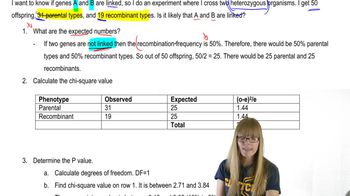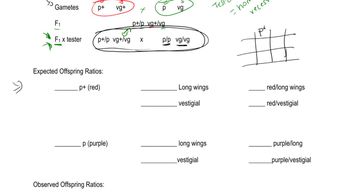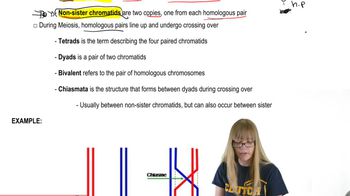Table of contents
- 1. Introduction to Genetics51m
- 2. Mendel's Laws of Inheritance3h 37m
- 3. Extensions to Mendelian Inheritance2h 41m
- 4. Genetic Mapping and Linkage2h 28m
- 5. Genetics of Bacteria and Viruses1h 21m
- 6. Chromosomal Variation1h 48m
- 7. DNA and Chromosome Structure56m
- 8. DNA Replication1h 10m
- 9. Mitosis and Meiosis1h 34m
- 10. Transcription1h 0m
- 11. Translation58m
- 12. Gene Regulation in Prokaryotes1h 19m
- 13. Gene Regulation in Eukaryotes44m
- 14. Genetic Control of Development44m
- 15. Genomes and Genomics1h 50m
- 16. Transposable Elements47m
- 17. Mutation, Repair, and Recombination1h 6m
- 18. Molecular Genetic Tools19m
- 19. Cancer Genetics29m
- 20. Quantitative Genetics1h 26m
- 21. Population Genetics50m
- 22. Evolutionary Genetics29m
4. Genetic Mapping and Linkage
Crossing Over and Recombinants
Problem 24b
Textbook Question
The boss in your laboratory has just heard of a proposal by another laboratory that genes for eye color and the length of body bristles may be linked in Drosophila. Your lab has numerous pure-breeding stocks of Drosophila that could be used to verify or refute genetic linkage. In Drosophila, red eyes (c⁺) are dominant to brown eyes (c) and long bristles (d⁺) are dominant to short bristles (d). Your lab boss asks you to design an experiment to test the genetic linkage of eye color and bristle-length genes, and to begin by crossing a pure-breeding line homozygous for red eyes and short bristles to a pure-breeding line that has brown eyes and long bristles.
Assume the eye color and bristle-length genes are separated by 28 m.u. What are the approximate frequencies of phenotypes expected from the cross you proposed in part (b)?
 Verified step by step guidance
Verified step by step guidance1
Start by identifying the genotypes of the pure-breeding lines. The line with red eyes and short bristles is homozygous dominant for eye color (c⁺) and homozygous recessive for bristle length (d), so its genotype is c⁺c⁺dd. The line with brown eyes and long bristles is homozygous recessive for eye color (c) and homozygous dominant for bristle length (d⁺), so its genotype is cc d⁺d⁺.
Perform the initial cross between the two pure-breeding lines: c⁺c⁺dd (red eyes, short bristles) x cc d⁺d⁺ (brown eyes, long bristles). The F1 generation will be heterozygous for both traits, with genotype c⁺c d⁺d.
Set up a test cross using the F1 generation (c⁺c d⁺d) and a homozygous recessive individual (cc dd). This will help reveal the linkage between the genes.
Calculate the expected recombinant and parental phenotypes. Since the genes are 28 map units apart, the recombination frequency is 28%. This means 28% of the offspring will be recombinant phenotypes, and 72% will be parental phenotypes.
Determine the expected phenotypic ratios. The parental phenotypes (red eyes, short bristles and brown eyes, long bristles) will make up 72% of the offspring, while the recombinant phenotypes (red eyes, long bristles and brown eyes, short bristles) will make up 28% of the offspring.
Recommended similar problem, with video answer:
 Verified Solution
Verified SolutionThis video solution was recommended by our tutors as helpful for the problem above
Video duration:
2mPlay a video:
Was this helpful?
Key Concepts
Here are the essential concepts you must grasp in order to answer the question correctly.
Genetic Linkage
Genetic linkage refers to the tendency of genes located close to each other on the same chromosome to be inherited together during meiosis. This phenomenon occurs because linked genes do not assort independently, leading to a higher probability of certain combinations of traits appearing together in offspring. Understanding linkage is crucial for predicting the outcomes of genetic crosses, especially when calculating phenotype frequencies.
Recommended video:
Guided course

Chi Square and Linkage
Drosophila Genetics
Drosophila melanogaster, commonly known as the fruit fly, is a model organism in genetics due to its simple genetic structure and short life cycle. In Drosophila, traits such as eye color and bristle length are determined by specific alleles, with dominance relationships influencing the phenotypic expression. Familiarity with Drosophila genetics allows researchers to design experiments and interpret results effectively, particularly in studies of inheritance patterns.
Recommended video:
Guided course

Drosophila P Element
Map Units and Recombination Frequency
Map units (m.u.) are a measure of genetic distance between genes, where 1 m.u. corresponds to a 1% chance of recombination occurring between two genes during meiosis. In the context of the question, a distance of 28 m.u. indicates that there is a 28% chance of recombination between the eye color and bristle-length genes. This information is essential for predicting the expected phenotype ratios in the offspring of the genetic cross.
Recommended video:
Guided course

Mapping Genes

 7:52m
7:52mWatch next
Master Gamete Genotypes with a bite sized video explanation from Kylia Goodner
Start learning




